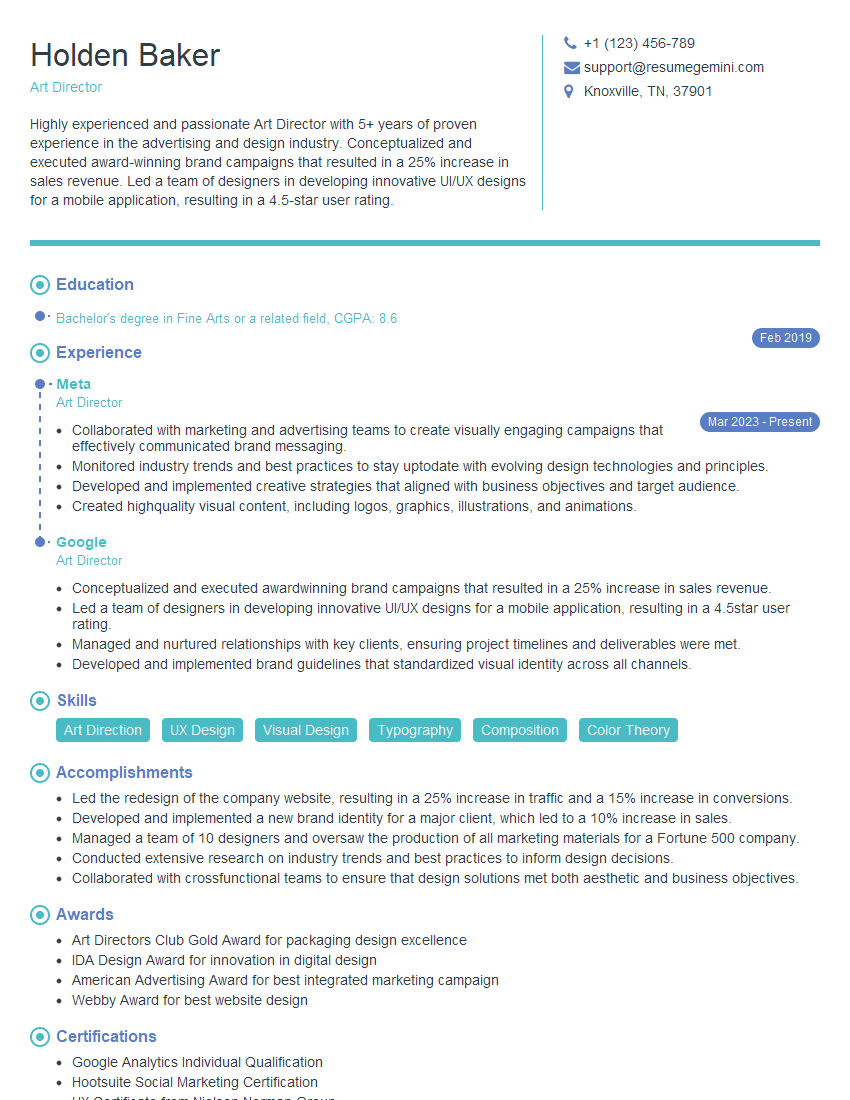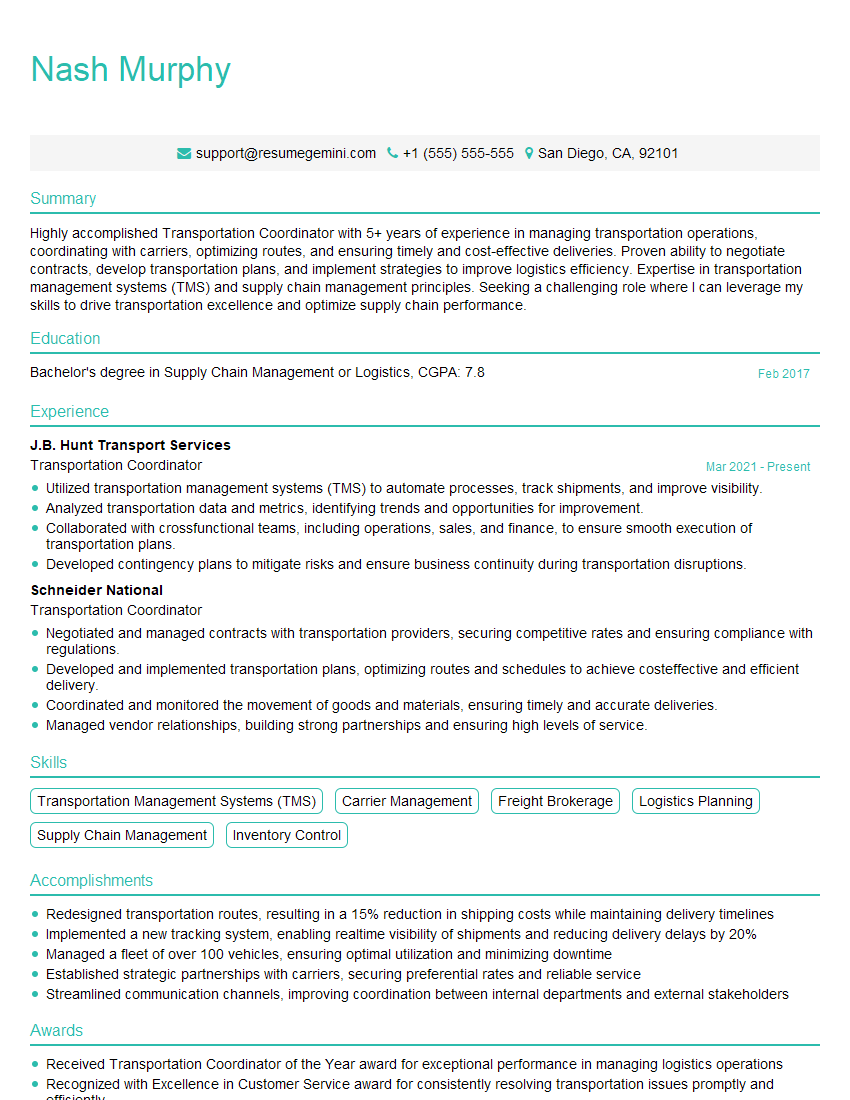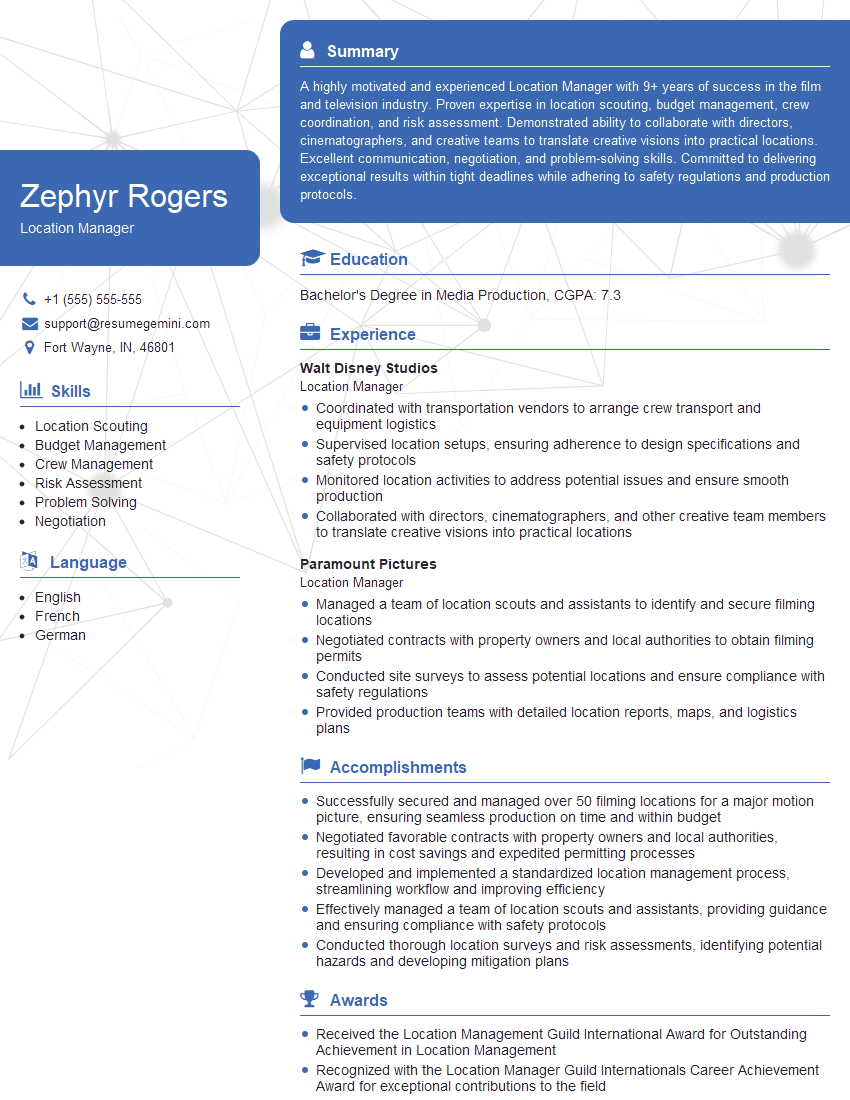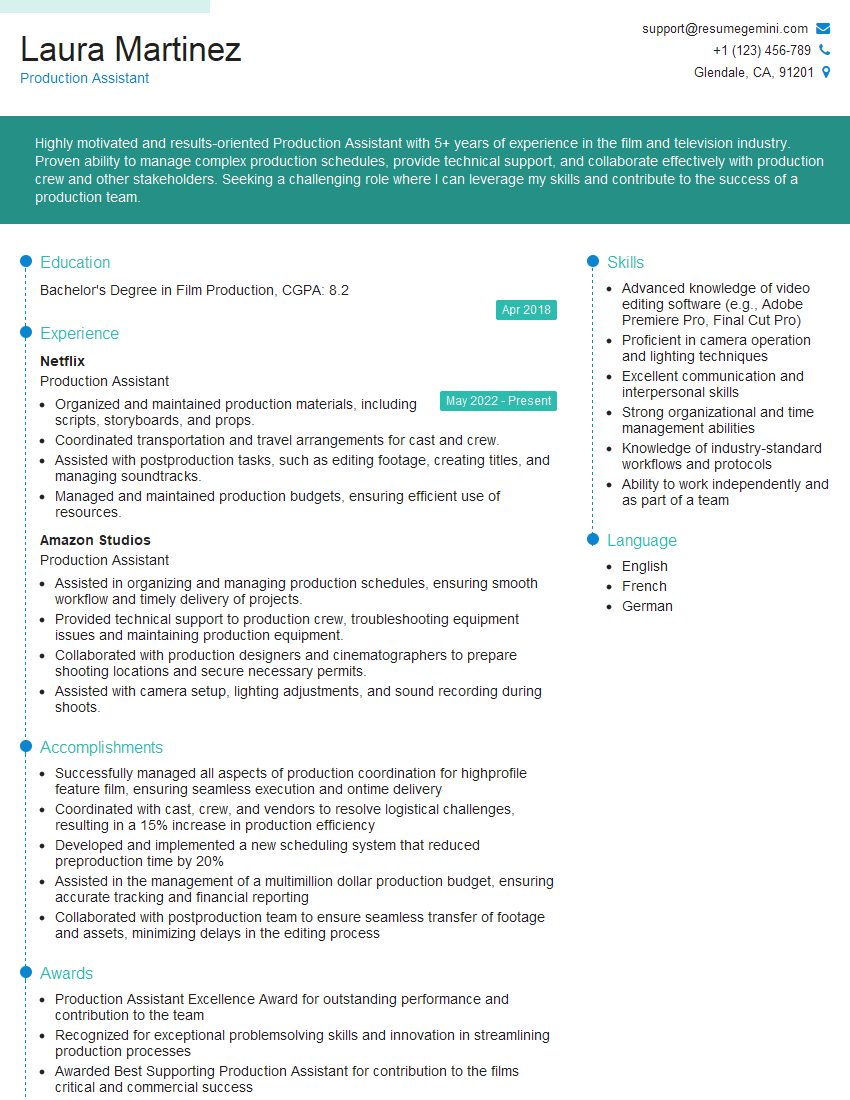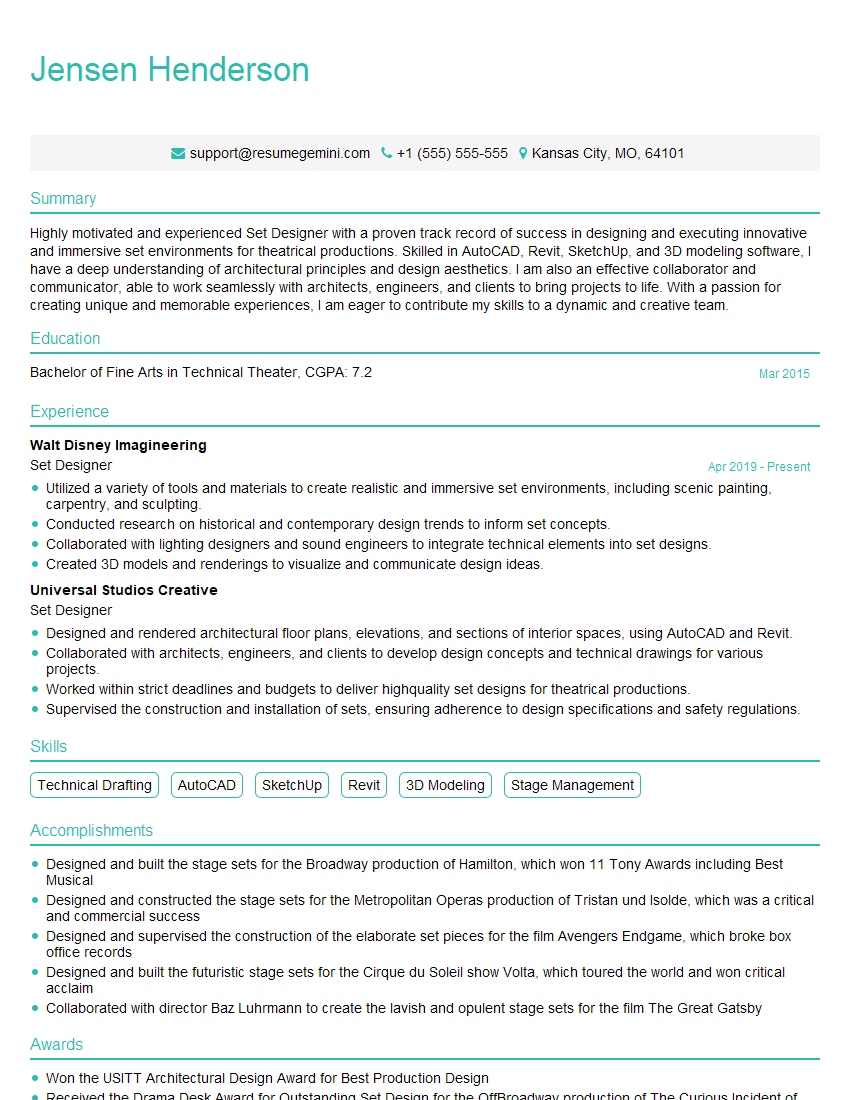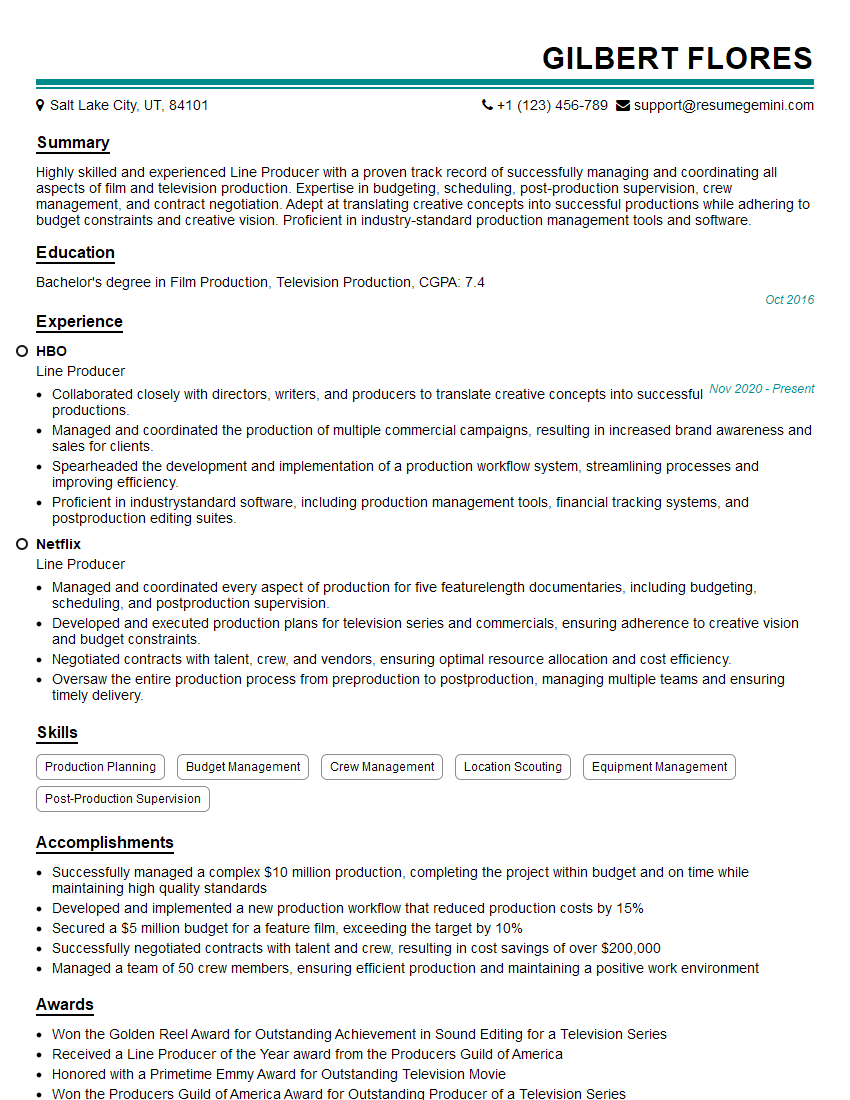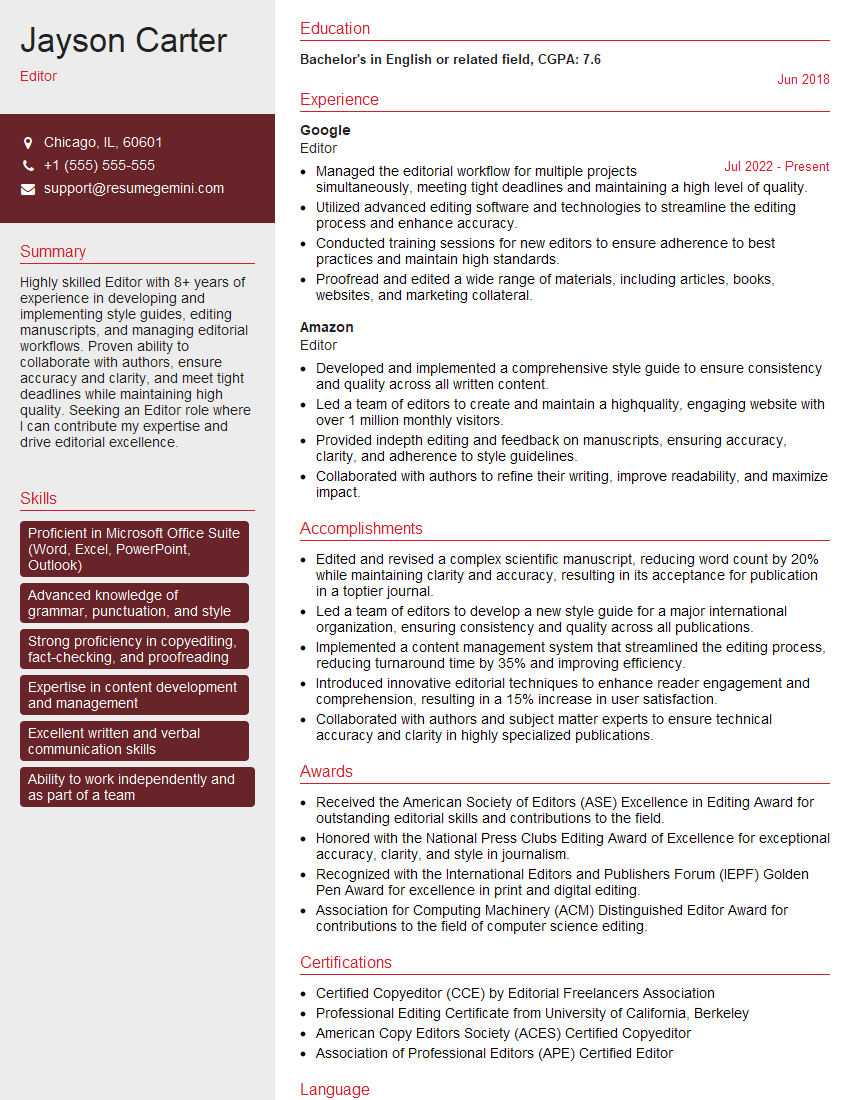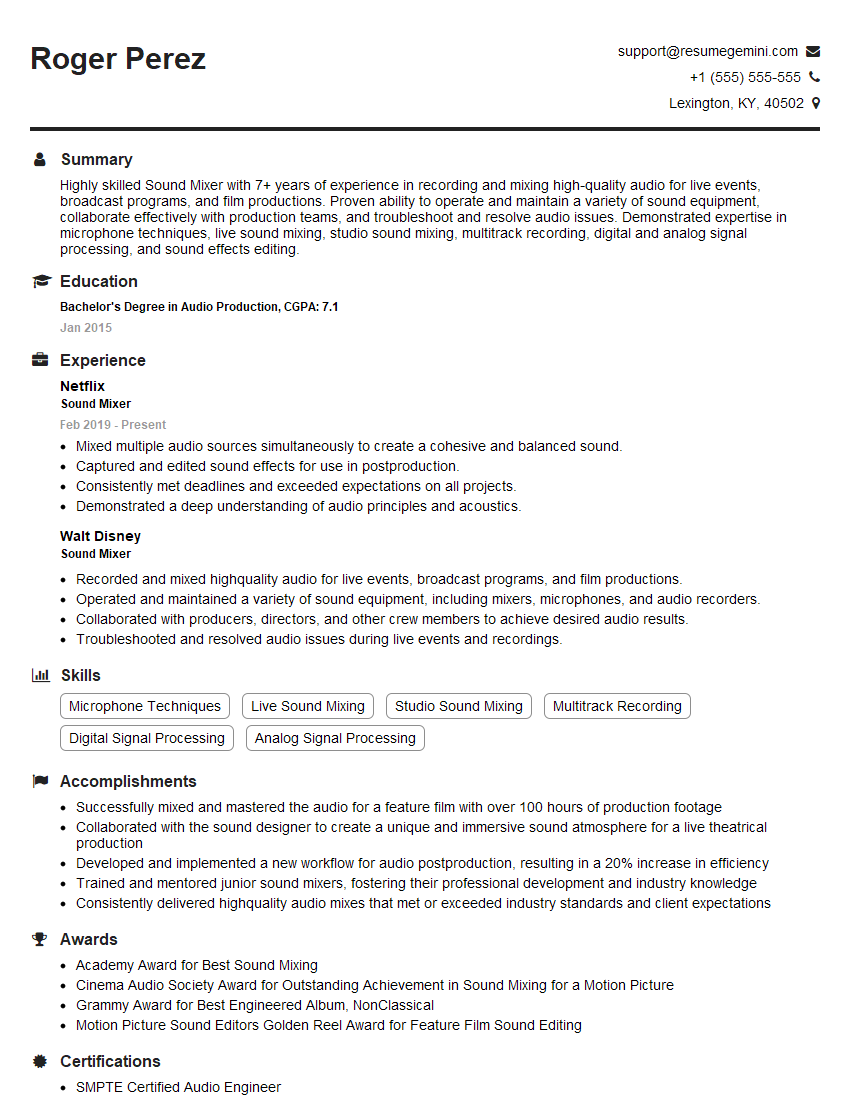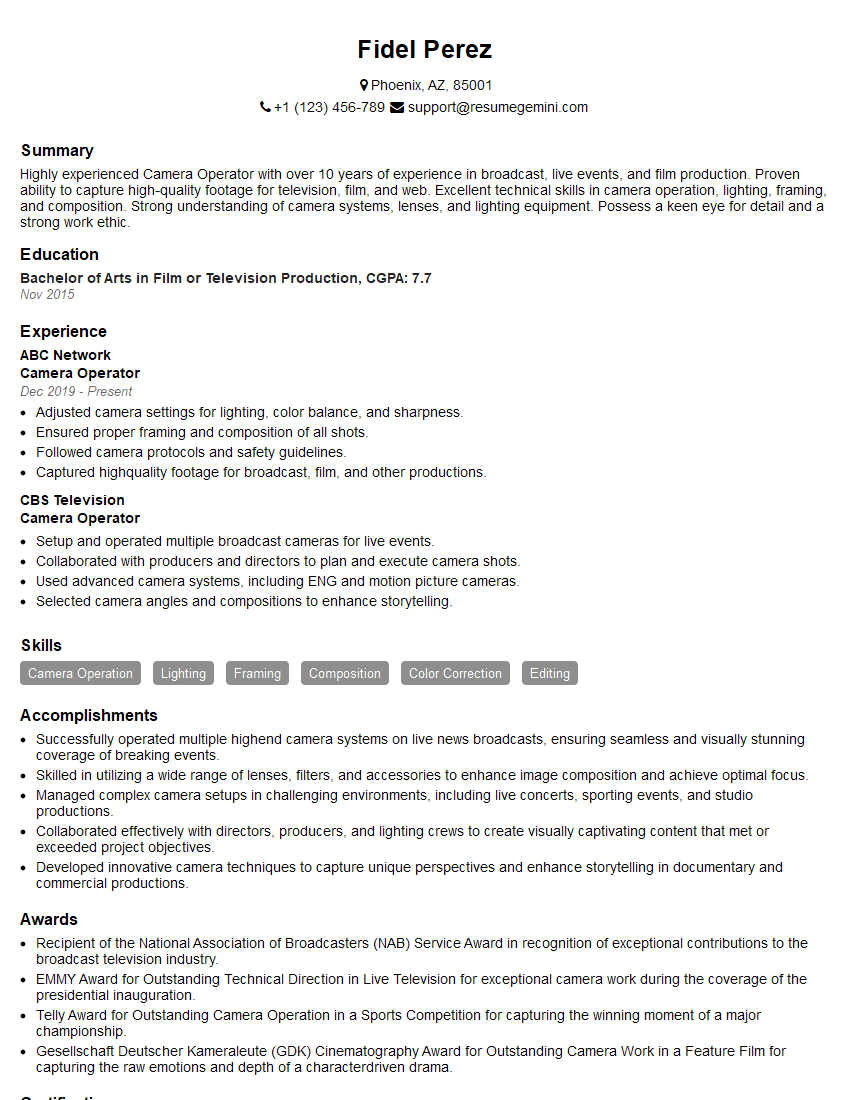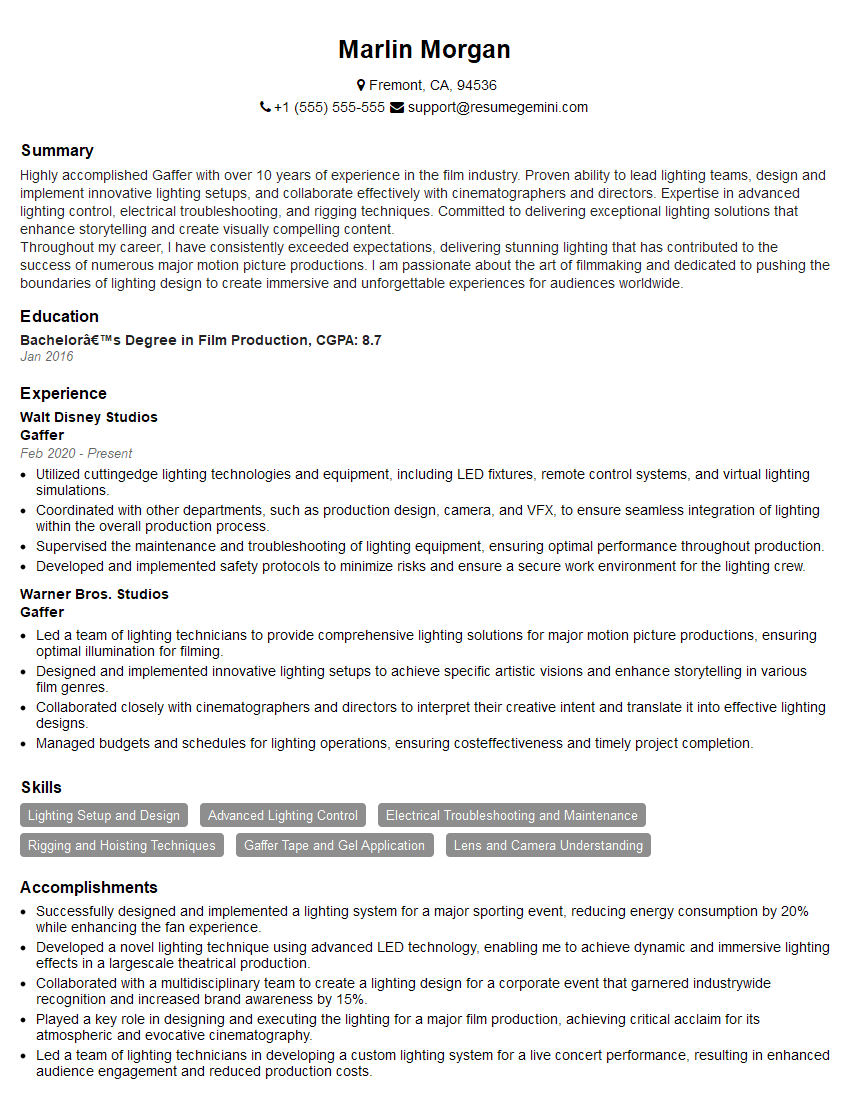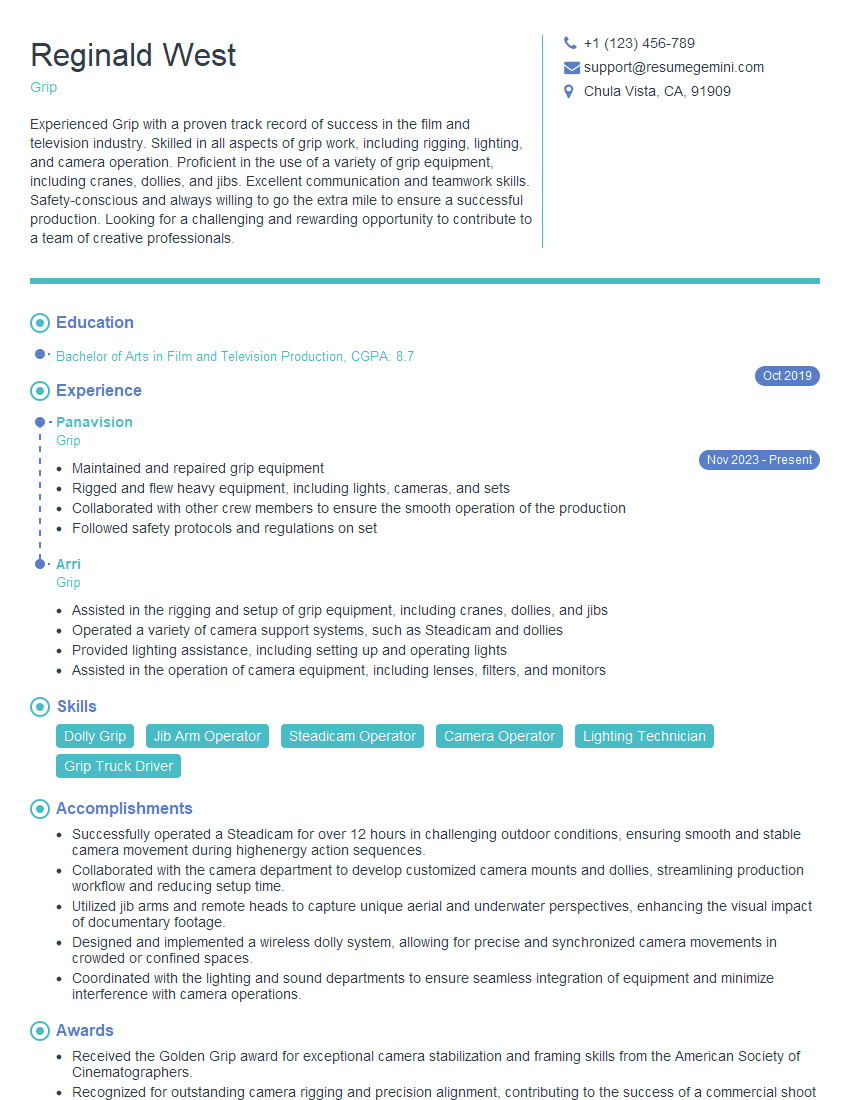The right preparation can turn an interview into an opportunity to showcase your expertise. This guide to Physical Production interview questions is your ultimate resource, providing key insights and tips to help you ace your responses and stand out as a top candidate.
Questions Asked in Physical Production Interview
Q 1. Describe your experience managing a production budget.
Managing a production budget requires meticulous planning and constant monitoring. It’s not just about allocating funds; it’s about understanding where every dollar goes and ensuring maximum efficiency. My approach begins with a detailed breakdown of anticipated costs across all departments – pre-production, production, and post-production. This includes everything from crew salaries and equipment rentals to location permits and catering. I use budgeting software to create a comprehensive spreadsheet, outlining line items and anticipated expenses. Then, I regularly track actual spending against the budget, flagging any potential overruns early. For example, on a recent independent film, we initially allocated $50,000 for location rentals. Through diligent scouting and negotiation, we secured the location for $42,000, allowing us to reinvest those savings in crucial areas like post-production sound design.
I also build in contingency funds to accommodate unexpected expenses, a critical element for mitigating risk. This proactive approach ensures that unforeseen challenges don’t derail the entire project. Finally, I maintain open communication with the production team and stakeholders, providing regular budget updates and explaining any necessary adjustments.
Q 2. How do you handle unexpected challenges on set?
Unexpected challenges are inevitable in physical production. My approach focuses on swift, decisive action and clear communication. The key is to remain calm and assess the situation systematically. For instance, if a key actor falls ill, I immediately activate a contingency plan, which might involve finding a replacement, rescheduling scenes, or adjusting the script to minimize disruption. Another time, we experienced a sudden equipment malfunction during a crucial night shoot. Having a backup plan (extra equipment readily available or a plan B shot) allowed us to resolve the situation within minutes, minimizing downtime and additional costs.
I firmly believe in empowering the crew. Encouraging problem-solving at every level creates a more resilient and adaptable team. Open communication is paramount; keeping everyone informed of the situation and the solutions being implemented maintains morale and keeps the production moving forward. Documentation of all changes and problem resolutions is also crucial for future project planning and improvements.
Q 3. Explain your process for scheduling and coordinating crew members.
Scheduling and coordinating crew members requires careful planning and robust organizational skills. It begins with a detailed shot list and a comprehensive production schedule, broken down into daily shooting schedules. I use specialized scheduling software (like StudioBinder or Production Board) to create a visual representation of the schedule, allocating crew members to specific days and tasks. This includes not only principal photography but also pre-production activities like location scouting and set design, and post-production tasks like editing and sound design.
Each crew member receives a personalized call sheet outlining their daily responsibilities, reporting times, and location details. I also ensure that all crew members’ schedules are coordinated to avoid conflicts. Regular meetings with department heads keep everyone informed of progress, potential challenges, and adjustments to the schedule. For example, coordinating the grip, lighting, and camera departments is critical for ensuring that every shot is properly set up and executed efficiently.
Q 4. What software or tools do you use for production planning?
I utilize a range of software and tools for production planning, each with its specific function. For scheduling and crew management, I rely on software like StudioBinder or Production Board. These platforms help create and manage schedules, assign tasks to crew members, and track progress. For budgeting, I use spreadsheet software such as Google Sheets or Excel to meticulously track expenses and ensure financial accountability. For communication and collaboration, I utilize project management tools like Asana or Trello to manage tasks, assign responsibilities, and facilitate communication among team members. Finally, for storyboarding and pre-visualization, I may use software like Adobe Photoshop or Storyboard Pro.
The choice of software depends on the project’s scope and complexity, but the core principle remains consistent: leveraging technology to optimize efficiency, collaboration, and communication throughout the production process.
Q 5. How do you ensure on-time and on-budget completion of a project?
Ensuring on-time and on-budget completion necessitates proactive planning, rigorous monitoring, and flexible adaptation. This begins with a well-defined production plan, establishing clear milestones and deadlines. Regular progress meetings are crucial for tracking against the schedule and addressing potential roadblocks. I also utilize a system of daily reports and progress tracking to stay ahead of any potential delays. For instance, if a scene is taking longer than expected, I immediately analyze the reasons and implement corrective actions, such as adjusting the shooting approach or optimizing the crew’s workflow.
Communication with the crew and stakeholders is vital. Keeping everyone informed of the project’s progress and any potential issues fosters a collaborative environment conducive to problem-solving. A culture of proactive risk management and contingency planning is essential to handle unexpected challenges effectively and minimizes the impact on timelines and budgets.
Q 6. Describe your experience with location scouting and securing permits.
My experience with location scouting and securing permits is extensive. It begins with thorough research, identifying locations that best suit the project’s aesthetic and logistical requirements. I utilize online resources, photographic archives, and personal connections to find suitable locations. Once potential locations are identified, I conduct on-site visits to assess their suitability, taking into account factors like accessibility, lighting conditions, and the availability of infrastructure. Detailed photographic documentation and sketches are key.
Securing permits involves navigating the local regulatory framework, understanding specific regulations, and preparing comprehensive applications that meticulously detail the project’s scope and potential impact on the location. I interact directly with local authorities to secure necessary permissions, ensuring compliance with all regulations and minimizing any potential conflicts or delays. This process often requires patience, diplomacy, and an understanding of local laws and procedures.
Q 7. How do you manage risk on a physical production set?
Risk management on a physical production set is paramount, encompassing a broad range of potential hazards. My approach is proactive and multi-layered. First, I conduct a thorough risk assessment, identifying potential hazards and their associated likelihood and severity. This involves considering factors such as weather conditions, equipment safety, and crew well-being. Then, I develop a comprehensive risk mitigation plan outlining preventive measures and contingency plans for each identified risk. This might include securing liability insurance, implementing strict safety protocols, and ensuring the availability of emergency equipment.
For example, during exterior shoots, I always have a weather contingency plan, including alternative shooting locations or rescheduling if necessary. Regular safety briefings for all crew members ensure everyone is aware of the safety protocols and their responsibilities. Maintaining a culture of safety awareness fosters a responsible working environment and prevents accidents. Finally, documenting all safety procedures and incidents is critical for future reference and continuous improvement.
Q 8. What is your experience with union contracts and regulations?
My experience with union contracts and regulations is extensive. I’ve worked on numerous productions governed by various unions, including IATSE and Teamsters. Understanding these contracts is crucial for ensuring smooth operations and avoiding costly disputes. This includes familiarity with provisions regarding wages, working hours, overtime, safety regulations, grievance procedures, and dispute resolution mechanisms. For example, on a recent project utilizing IATSE members, I successfully negotiated an expedited call-time schedule that met both union guidelines and the production’s tight deadline, preventing potential overtime costs and maintaining positive working relationships. I’m adept at interpreting complex contract language, applying relevant regulations, and proactively identifying potential conflicts before they escalate. I maintain up-to-date knowledge of relevant labor laws and industry best practices.
Q 9. How do you handle conflict resolution within a production team?
Conflict resolution within a production team requires a proactive and empathetic approach. My strategy centers around open communication, active listening, and collaborative problem-solving. I believe in addressing issues directly and privately whenever possible, creating a safe space for team members to voice their concerns. I typically employ a structured approach: I first identify the root cause of the conflict, focusing on the facts rather than personal opinions. Then, I facilitate a discussion to understand each individual’s perspective. Next, I help the team collaboratively brainstorm solutions, ensuring all parties feel heard and valued. Finally, we agree on a concrete action plan with clear responsibilities and timelines. For instance, on one occasion, a disagreement arose between the lighting and grip departments over equipment allocation. By facilitating a meeting, understanding their individual constraints, and jointly reallocating resources, I resolved the conflict efficiently, preventing workflow disruption. The emphasis is always on preserving professional relationships while ensuring project objectives are met.
Q 10. Describe your experience with equipment rentals and logistics.
My experience with equipment rentals and logistics is substantial. From securing specialized camera equipment to coordinating the transport of heavy-duty gear across various locations, I have a proven track record of efficient and cost-effective management. This involves working closely with rental houses, negotiating rates, overseeing timely delivery and pickup, creating detailed equipment lists, and tracking inventory. I utilize project management software to streamline the process, ensuring all equipment is readily available when needed and returned promptly. For example, I once managed the rental of a complex crane system for a large-scale outdoor shoot. Through meticulous planning, including securing permits for transport, I successfully coordinated delivery and setup, ensuring the equipment was fully operational and ready for use without delays. I understand the importance of insurance and liability waivers and ensure these are properly handled. Efficient logistics translates to significant cost savings and project success.
Q 11. How do you maintain accurate production records and documentation?
Maintaining accurate production records and documentation is paramount for efficiency, accountability, and legal compliance. I use a combination of digital and physical methods, employing specialized software for production tracking, time sheets, and expense reports. This typically involves daily reports summarizing the day’s activities, including footage shot, equipment used, crew attendance, and any challenges encountered. All documentation is meticulously organized and easily accessible. For instance, I maintain a comprehensive digital database detailing each production’s daily progress reports, along with related expense reports and invoices. This detailed system allows for swift access to vital information for audits, post-production analysis, and budget reconciliation. This rigorous approach ensures clear communication among all stakeholders and facilitates accurate financial reporting.
Q 12. What is your familiarity with various production workflows?
I’m familiar with a wide range of production workflows, from linear to agile methodologies. My experience includes working on projects employing various shooting styles, including single-camera setups, multi-camera productions, and documentary-style filming. I’m adept at adapting to different workflows depending on the project’s unique needs and budget. For instance, I’ve worked on projects utilizing lean methodologies, minimizing waste and maximizing efficiency. In other projects, I’ve used more traditional linear workflows, focusing on pre-production planning and meticulous scheduling. My understanding extends to various post-production workflows as well, including video editing, sound mixing, and color correction. I’m proficient at coordinating different teams and stages of production to ensure a smooth and efficient process from script to final delivery.
Q 13. Explain your approach to safety procedures on a film set.
Safety on a film set is my top priority. My approach is proactive and multi-faceted. It begins with a thorough risk assessment at the pre-production stage, identifying potential hazards specific to each location and production. This involves collaborating with safety officers, implementing safety protocols, and providing comprehensive training to the crew. Throughout production, I actively monitor the set for any potential hazards and enforce safety regulations. This includes proper use of equipment, adherence to safety guidelines, and ensuring all crew members are aware of and comply with safety measures. In addition, clear communication channels are crucial; I ensure everyone understands their responsibilities and knows how to report any incidents or concerns. For example, I once implemented a comprehensive safety training program that included practical demonstrations and emergency drills resulting in a zero-incident production. This commitment to safety fosters a respectful and secure environment for everyone on set.
Q 14. How do you communicate effectively with diverse teams?
Effective communication with diverse teams requires cultural sensitivity, clear articulation, and active listening. I approach communication by adapting my style to suit the audience; I avoid jargon and use clear, concise language. I’m a strong believer in open communication, encouraging feedback and questions at every stage of the production. I also prioritize building relationships, fostering trust and respect amongst crew members. I actively seek to understand different communication styles and perspectives, ensuring that everyone feels heard and valued. For example, on an international project, I effectively coordinated communication between crew members speaking different languages by using translators and ensuring key information was available in multiple languages. Building trust and respect creates a collaborative environment where everyone feels comfortable contributing their expertise.
Q 15. What is your experience with post-production coordination?
Post-production coordination involves overseeing all aspects of a project once principal photography wraps. This includes managing the assembly of footage, sound editing, visual effects, color grading, and final delivery. It’s like being an orchestra conductor, ensuring all the different sections (editors, sound designers, VFX artists) work in harmony to achieve a cohesive final product.
My experience encompasses coordinating multiple projects simultaneously, ensuring deadlines are met, budgets are adhered to, and creative visions are realized. For example, on a recent documentary, I successfully navigated a complex post-production schedule involving archival footage restoration, extensive sound mixing and music composition, and the creation of several motion graphics sequences. This required meticulous tracking of deliverables, proactive communication with various vendors, and regular progress reports to the client.
- Asset Management: I’ve implemented robust asset management systems to track and organize vast amounts of raw footage and post-production files, minimizing confusion and ensuring smooth workflows.
- Vendor Management: I effectively manage relationships with post-production vendors, negotiating rates, ensuring high-quality deliverables, and resolving any arising disputes.
- Budget Management: I meticulously track post-production spending, ensuring we stay within budget and identify potential cost overruns early on.
Career Expert Tips:
- Ace those interviews! Prepare effectively by reviewing the Top 50 Most Common Interview Questions on ResumeGemini.
- Navigate your job search with confidence! Explore a wide range of Career Tips on ResumeGemini. Learn about common challenges and recommendations to overcome them.
- Craft the perfect resume! Master the Art of Resume Writing with ResumeGemini’s guide. Showcase your unique qualifications and achievements effectively.
- Don’t miss out on holiday savings! Build your dream resume with ResumeGemini’s ATS optimized templates.
Q 16. Describe your proficiency in scheduling software (e.g., StudioBinder, Celtx)
I’m highly proficient in several scheduling softwares, including StudioBinder and Celtx. These tools are invaluable for planning and executing complex productions. They help to create comprehensive schedules, track progress, manage resources, and facilitate communication amongst the team. Think of them as the central nervous system of a production.
StudioBinder, in particular, excels at its integrated budgeting and communication features. I’ve used it extensively to create detailed breakdowns, assign tasks, monitor daily progress, and generate reports to stakeholders. Celtx offers a strong scripting and storyboarding component, which is especially useful for pre-production planning. For instance, on a recent commercial shoot, utilizing StudioBinder allowed us to effectively manage the schedule, resulting in a 15% reduction in shooting days and significant cost savings.
My proficiency extends beyond just using the software. I understand how to leverage their features to optimize workflows, anticipate potential issues and proactively develop contingency plans. I can adapt my approach based on the project’s specifics, ensuring the software is used effectively, and not just as a fancy calendar.
Q 17. How do you manage the logistics of transporting equipment and personnel?
Managing logistics for equipment and personnel is crucial for smooth production. It’s about the meticulous planning and execution that keeps everything running like a well-oiled machine. This involves creating detailed transport plans, coordinating with rental houses, securing permits, and arranging accommodation for the crew.
My approach is methodical. I start by creating a comprehensive inventory of all equipment and personnel, considering their specific needs and requirements. Then, I develop detailed transportation schedules, outlining pickup and delivery times, routes, and personnel assignments. This often includes using specialized transportation for delicate equipment. I also coordinate with local authorities to secure any necessary permits for filming in specific locations. For example, on a remote location shoot, I successfully coordinated the transport of sensitive camera equipment via helicopter, ensuring its safe arrival while adhering to strict environmental regulations.
Ensuring the crew has comfortable and appropriate accommodation is also key. This goes beyond just booking rooms; it’s about understanding the crew’s needs, particularly for long shoots, and providing a conducive environment for productivity.
Q 18. Explain your experience with securing insurance for a production.
Securing adequate insurance is paramount for any production, mitigating potential financial losses from accidents, damages, or legal liabilities. This involves working closely with insurance brokers to determine the necessary coverage, understanding policy details, and ensuring all necessary documentation is in place.
My experience includes working with various insurance providers to secure comprehensive liability insurance, equipment insurance, and workers’ compensation. I understand the intricacies of different insurance policies and can tailor coverage to the specific needs of each production. For example, on a high-risk stunt-heavy film, I worked with the insurance broker to carefully assess the risks involved and secure specialized coverage to protect the production against potential liability. This involved detailed risk assessments, safety protocols, and regular communication with the insurance provider. It’s about being proactive and thorough to ensure the production is adequately protected.
Q 19. How do you track and manage production expenses?
Tracking and managing production expenses requires a robust system, combining careful budgeting, meticulous record-keeping, and regular financial reporting. I use a combination of spreadsheets, accounting software, and project management tools to maintain a clear and accurate financial overview.
My process starts with detailed budgeting in the pre-production phase. I work closely with the producer to create a comprehensive budget, breaking down costs into different categories (personnel, equipment, location, etc.). During production, I meticulously track all expenses, using receipts and invoices to verify every item. I regularly reconcile these figures against the budget to identify potential overruns or discrepancies. At the end of the project, I generate comprehensive financial reports, summarizing all income and expenses, and providing an accurate accounting of the project’s financial performance. For example, on a recent music video, using a cloud-based accounting software enabled me to collaborate with the finance team in real-time, giving an up to date accurate budget view.
Q 20. What is your experience with different shooting formats (e.g., film, digital)?
I possess extensive experience with various shooting formats, including film and digital. Understanding the strengths and limitations of each format is essential for making informed decisions about image quality, workflow efficiency, and budget considerations.
Film offers a unique aesthetic and grain structure, which can be highly desirable for certain projects. However, it’s more expensive and requires specialized processing. Digital, on the other hand, offers greater flexibility, immediate feedback, and lower costs. I’ve worked on projects that have utilized both, adapting my approach based on the creative vision, budget limitations, and technical requirements. For example, a recent period drama benefited greatly from the rich color and texture of film, while a fast-paced commercial production prioritized the efficiency and speed of digital shooting.
My knowledge extends to working with different camera systems, sensors, and resolutions, tailoring my approach to the needs of each specific project. I am familiar with the technical aspects of image acquisition and ensure that the production team consistently maintains the required quality standards.
Q 21. Describe your problem-solving skills in relation to on-set technical issues.
Problem-solving on set is critical. Technical issues can arise unexpectedly, requiring quick thinking, resourcefulness, and a calm demeanor under pressure. My approach is systematic, focusing on identifying the root cause of the problem, developing potential solutions, and implementing the most efficient one.
My process typically involves these steps:
- Assessment: Accurately identify the problem, gathering information from various team members.
- Troubleshooting: Systematically investigate the problem, ruling out potential causes. This could involve checking cables, power supplies, camera settings, or even consulting with technical specialists.
- Solution Development: Brainstorm potential solutions, weighing the pros and cons of each approach.
- Implementation: Implement the chosen solution, documenting the process and outcome.
- Prevention: After resolving the issue, analyze what went wrong and implement preventative measures to avoid similar problems in the future.
For example, during a night shoot, a crucial lighting fixture malfunctioned. By systematically checking the power supply, fuses, and cables, I quickly identified a loose connection. By fixing the connection, we avoided a significant delay and kept the production on schedule. This involved efficient communication between the lighting technicians, grip crew, and the director to minimize disruption.
Q 22. How do you ensure compliance with relevant industry regulations?
Ensuring compliance with industry regulations is paramount in physical production. It’s not just about avoiding penalties; it’s about upholding ethical standards and ensuring the safety and well-being of the crew and the environment. This involves a multi-pronged approach.
- Understanding the Regulations: I meticulously research and stay updated on all relevant regulations, including those related to health and safety (OSHA, for example), environmental protection (EPA regulations for waste disposal on location), labor laws (fair wages, working hours, and union agreements), and any specific local ordinances that might apply to the production location.
- Implementing Procedures: I develop and implement comprehensive safety protocols, including risk assessments, emergency plans, and regular safety training for the crew. This often involves working closely with safety officers and creating detailed documentation of safety procedures and risk mitigation strategies.
- Documenting Compliance: Thorough documentation is key. I maintain detailed records of all safety training, inspections, permits, and any incidents that occur on set. This documentation provides a transparent audit trail demonstrating our commitment to compliance and helps in case of any investigations or audits.
- Continuous Improvement: Compliance is not a one-time effort. I regularly review our procedures and identify areas for improvement based on feedback from the crew, audits, and industry best practices. This proactive approach helps ensure ongoing compliance and a safer working environment.
For instance, on a recent project, we were filming near a protected wildlife area. I coordinated with local authorities to obtain the necessary permits and implemented strict guidelines to minimize our environmental impact, including a detailed waste management plan and restrictions on vehicle access to certain areas. This proactive approach avoided potential delays and legal issues.
Q 23. What is your experience with working with diverse casts and crews?
Working with diverse casts and crews is not just a matter of inclusivity; it’s a key ingredient for creative success. Different backgrounds and experiences bring unique perspectives, enriching the creative process and leading to more innovative solutions.
- Cultural Sensitivity: I prioritize creating an inclusive and respectful environment, mindful of cultural differences in communication styles, work ethics, and personal preferences. This includes ensuring equitable representation across all roles and fostering open communication among crew members from diverse backgrounds.
- Communication Strategies: Clear and consistent communication is crucial. I adapt my communication style as needed to effectively interact with individuals from various backgrounds and ensure everyone feels heard and understood. This sometimes involves using translators or employing visual aids to bridge communication gaps.
- Conflict Resolution: Inevitably, differences may arise. I am adept at mediating conflicts and resolving disagreements fairly and efficiently, utilizing active listening and focusing on finding mutually agreeable solutions.
- Team Building: I actively foster teamwork and collaboration by organizing team-building activities and creating opportunities for crew members to interact and build relationships. This contributes to a positive and supportive work environment and promotes higher productivity.
On one project, we had a crew comprised of individuals from several different countries. By proactively addressing potential communication barriers, emphasizing inclusivity, and fostering a culture of respect, we successfully completed the project on time and exceeded expectations. The diverse perspectives actually led to more creative problem-solving during production.
Q 24. How do you adapt to changing production circumstances?
Adaptability is crucial in physical production. Unexpected challenges, from equipment malfunctions to weather changes, are inevitable. Successfully navigating these situations requires a combination of planning, problem-solving, and resourcefulness.
- Contingency Planning: I always develop detailed contingency plans to address potential challenges. This includes having backup equipment, alternative shooting locations, and flexible scheduling.
- Problem-Solving: When unexpected issues arise, I approach them systematically. This involves clearly defining the problem, identifying possible solutions, assessing the risks and benefits of each solution, selecting the most appropriate course of action, and implementing it effectively.
- Communication and Collaboration: Keeping all stakeholders informed is critical. I maintain clear communication with the director, crew, and clients, ensuring transparency and collaboration in decision-making during unforeseen events.
- Decision-Making Under Pressure: The ability to make timely and well-informed decisions under pressure is paramount. I rely on my experience and problem-solving skills to quickly assess situations and choose the best course of action, minimizing disruptions and keeping the production on track.
For example, during an outdoor shoot, we encountered unexpected torrential rain. I immediately activated our contingency plan, relocating the shoot to an indoor location, and adjusting the schedule to accommodate the delay. This swift and decisive action minimized the impact on the production schedule and budget.
Q 25. What is your understanding of production accounting principles?
Production accounting principles are fundamental to managing a film’s financial health. A solid grasp of these principles ensures cost-effective production, accurate budgeting, and transparent financial reporting.
- Budgeting and Cost Control: I understand how to create and manage budgets, tracking expenses meticulously and implementing strategies to maintain cost control throughout the production lifecycle. This includes using cost-reporting software and regularly analyzing spending patterns to identify potential overruns.
- Expense Tracking and Reporting: Accurate and timely expense tracking is crucial. I am proficient in using various accounting software and methods to record and categorize all production expenditures, ensuring that all financial transactions are properly documented and auditable.
- Financial Reporting: I prepare regular financial reports for stakeholders, providing clear and concise information on the financial status of the production, including budget vs. actual spending, and highlighting any potential issues or variances.
- Compliance with Accounting Standards: I am familiar with relevant accounting standards and regulations, ensuring that all financial procedures are compliant with legal requirements.
For example, I’ve used software like Final Draft for budgeting and Celtx for scheduling and budgeting to effectively monitor costs and ensure that a project stays within budget. A thorough understanding of these systems allow for informed decision-making during production.
Q 26. Describe your experience with pre-production planning.
Pre-production planning is the bedrock of a successful physical production. It’s the phase where the foundation for the entire production is laid. Effective pre-production planning minimizes risks, streamlines workflows, and ultimately leads to a more efficient and cost-effective production.
- Script Breakdown: I meticulously break down the script, identifying all the necessary locations, props, costumes, and personnel required for each scene. This forms the basis for the production schedule and budget.
- Scheduling: I create a detailed shooting schedule, optimizing the use of resources and minimizing downtime. This involves factoring in travel time, setup time, and potential delays.
- Location Scouting and Management: I conduct thorough location scouting, considering factors like accessibility, permits, and potential challenges. I secure necessary permits and arrange for logistics such as transportation and accommodation.
- Crew Hiring: I collaborate with the production manager to assemble a skilled and efficient crew. This includes hiring key personnel such as the director of photography, sound recordist, and grip team.
- Budgeting: I work with the production accountant to create a detailed budget, forecasting all costs associated with the production.
In a recent project, meticulous pre-production planning allowed us to anticipate and mitigate a potential location issue. During location scouting, we identified a potential conflict with local community events. By proactively addressing this, we secured an alternative location well in advance, avoiding costly delays and disruptions during the shoot.
Q 27. How do you collaborate effectively with directors and other department heads?
Effective collaboration with directors and other department heads is essential for a smooth and successful production. Open communication, mutual respect, and a shared understanding of goals are key to achieving this.
- Open Communication: I maintain open and consistent communication channels with the director and other department heads. This involves regular meetings, progress reports, and proactive problem-solving.
- Mutual Respect: I value the expertise and perspectives of other department heads, fostering a collaborative environment based on mutual respect and understanding.
- Shared Goals: I work closely with the director and other department heads to establish clear goals and expectations, ensuring alignment and collaboration across all departments.
- Conflict Resolution: When disagreements arise, I facilitate open dialogue and actively participate in finding mutually acceptable solutions.
For example, on a recent project, a disagreement arose between the director and the cinematographer regarding a particular shot. By facilitating open communication and collaborative problem-solving, we were able to reach a compromise that satisfied both parties and enhanced the overall visual quality of the scene.
Q 28. Explain your experience with negotiating contracts with vendors.
Negotiating contracts with vendors is a crucial aspect of physical production. It requires a combination of business acumen, negotiation skills, and a thorough understanding of the industry.
- Research and Preparation: Before initiating negotiations, I thoroughly research potential vendors, comparing pricing, services, and reputation. I also carefully review the vendor’s terms and conditions.
- Clear Communication: I clearly articulate our needs and expectations to the vendor, ensuring a shared understanding of the scope of work and deliverables.
- Negotiation Strategies: I employ various negotiation strategies, including exploring different pricing models, negotiating payment terms, and securing favorable contractual terms.
- Contract Review: Before finalizing any contract, I carefully review all terms and conditions, ensuring that they align with our production’s needs and protect our interests.
In one instance, we were negotiating a contract with a camera rental company. Through careful research and effective negotiation, I secured a lower rental rate than originally quoted, and also negotiated a favorable insurance clause that protected us against equipment damage. This saved the production a significant amount of money.
Key Topics to Learn for Physical Production Interview
- Production Scheduling & Budgeting: Understanding production schedules, budgeting principles, and resource allocation strategies. Practical application includes creating realistic schedules and managing budgets within constraints.
- Location Scouting & Management: Knowing the process of finding suitable locations, securing permits, and managing on-site logistics. Practical application involves assessing location suitability based on production needs and risk mitigation.
- Crew Management & Communication: Understanding crew roles, responsibilities, and effective communication techniques. Practical application includes fostering teamwork and resolving conflicts on set.
- Equipment & Logistics: Familiarity with various production equipment, their functionalities, and logistical planning for transport and setup. Practical application includes troubleshooting equipment issues and optimizing workflow.
- Safety & Compliance: Knowledge of industry safety regulations and compliance procedures. Practical application includes ensuring a safe working environment and adhering to legal requirements.
- Post-Production Workflow: Understanding the hand-off process from physical production to post-production, including digital asset management and collaboration. Practical application involves efficient organization and delivery of materials.
- Problem-Solving & Decision-Making under Pressure: Demonstrating the ability to think critically and make informed decisions in fast-paced, high-pressure environments. Practical application involves anticipating potential problems and developing contingency plans.
Next Steps
Mastering Physical Production opens doors to exciting and rewarding careers in film, television, and other creative industries. A strong understanding of these core principles is crucial for career advancement and securing your dream role. To significantly enhance your job prospects, it’s vital to create an ATS-friendly resume that highlights your skills and experience effectively. We recommend using ResumeGemini, a trusted resource, to build a professional and impactful resume. ResumeGemini provides examples of resumes tailored specifically to Physical Production roles, giving you a head start in crafting a compelling application.
Explore more articles
Users Rating of Our Blogs
Share Your Experience
We value your feedback! Please rate our content and share your thoughts (optional).
What Readers Say About Our Blog
Hello,
We found issues with your domain’s email setup that may be sending your messages to spam or blocking them completely. InboxShield Mini shows you how to fix it in minutes — no tech skills required.
Scan your domain now for details: https://inboxshield-mini.com/
— Adam @ InboxShield Mini
Reply STOP to unsubscribe
Hi, are you owner of interviewgemini.com? What if I told you I could help you find extra time in your schedule, reconnect with leads you didn’t even realize you missed, and bring in more “I want to work with you” conversations, without increasing your ad spend or hiring a full-time employee?
All with a flexible, budget-friendly service that could easily pay for itself. Sounds good?
Would it be nice to jump on a quick 10-minute call so I can show you exactly how we make this work?
Best,
Hapei
Marketing Director
Hey, I know you’re the owner of interviewgemini.com. I’ll be quick.
Fundraising for your business is tough and time-consuming. We make it easier by guaranteeing two private investor meetings each month, for six months. No demos, no pitch events – just direct introductions to active investors matched to your startup.
If youR17;re raising, this could help you build real momentum. Want me to send more info?
Hi, I represent an SEO company that specialises in getting you AI citations and higher rankings on Google. I’d like to offer you a 100% free SEO audit for your website. Would you be interested?
Hi, I represent an SEO company that specialises in getting you AI citations and higher rankings on Google. I’d like to offer you a 100% free SEO audit for your website. Would you be interested?
good

